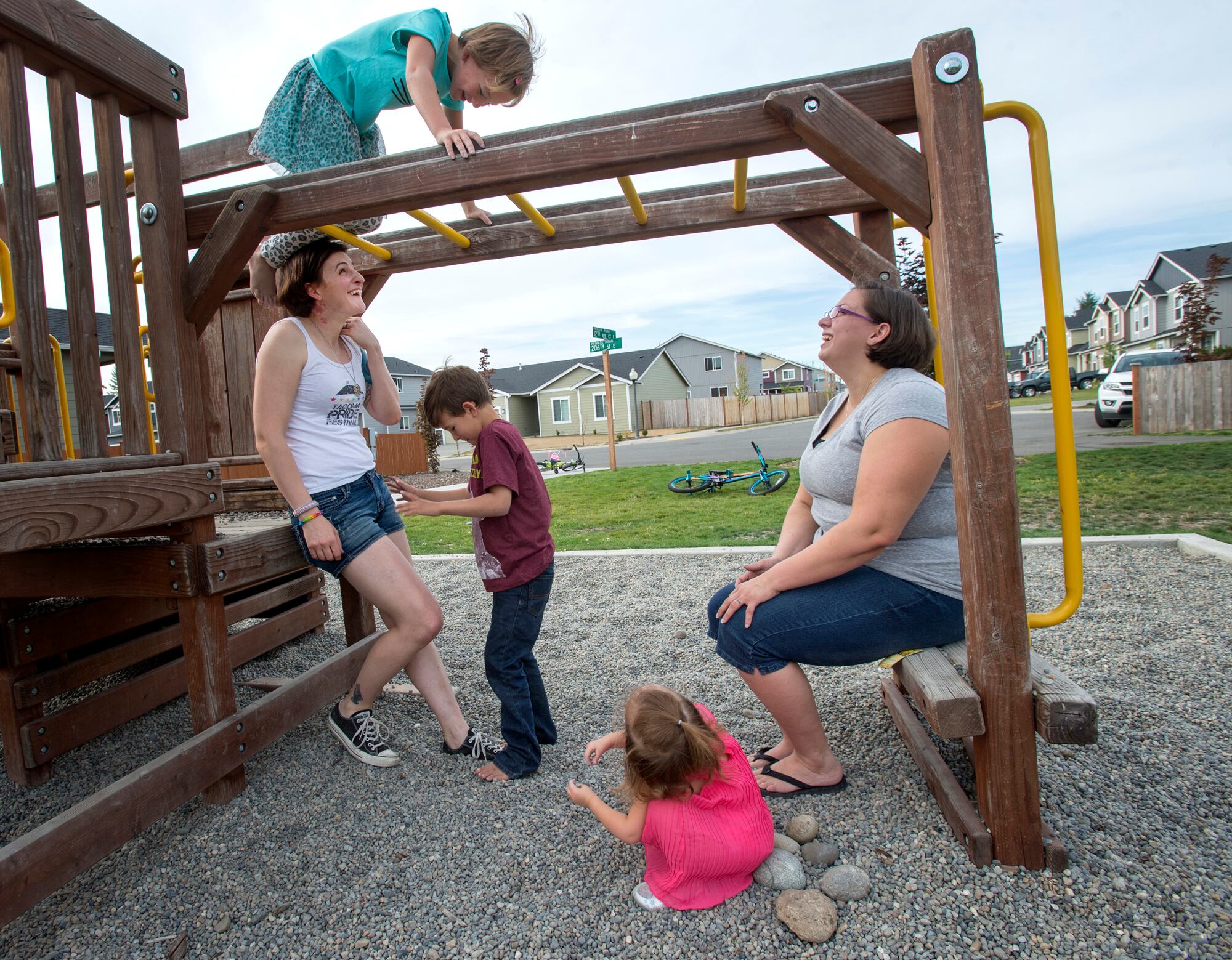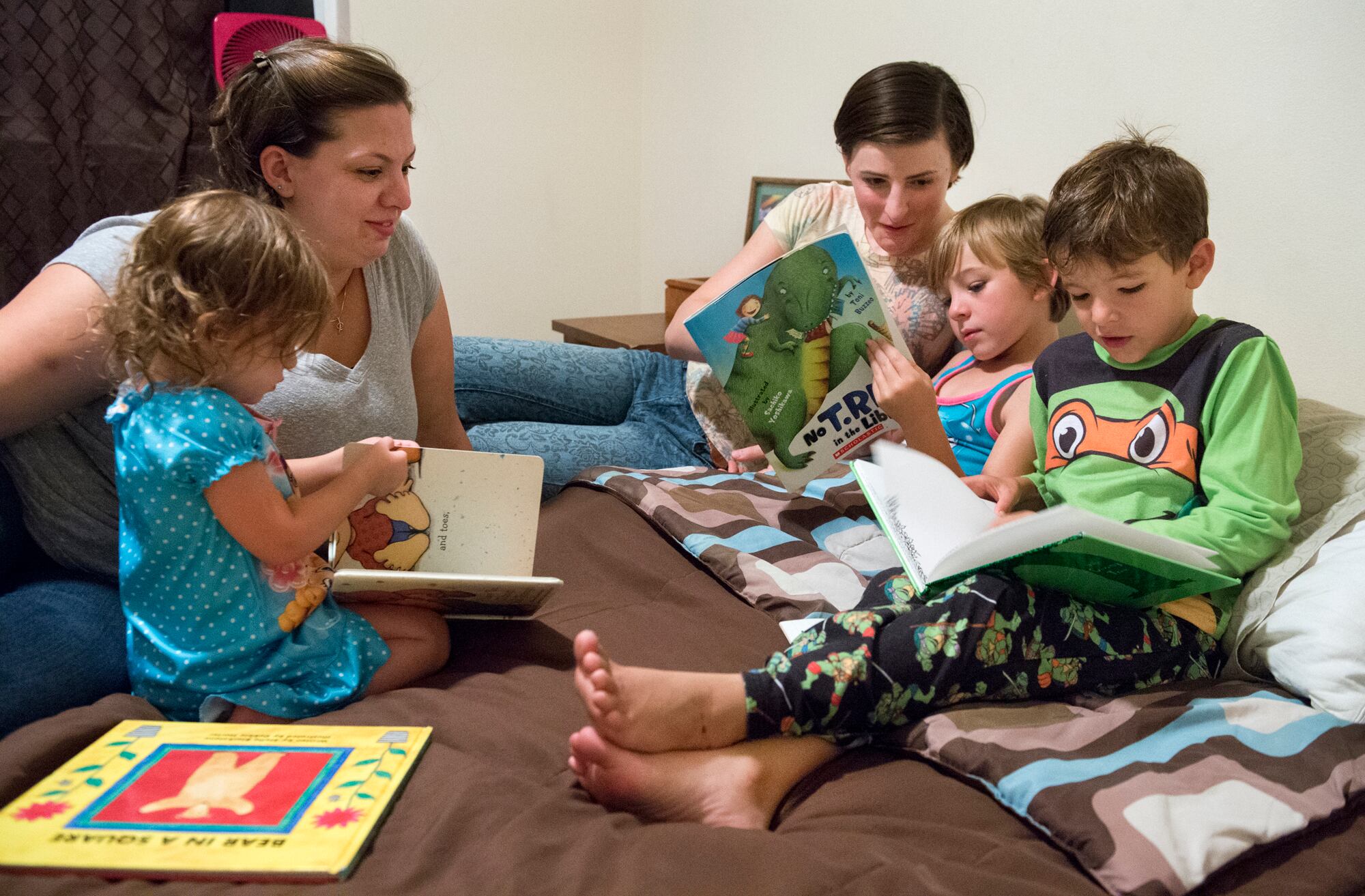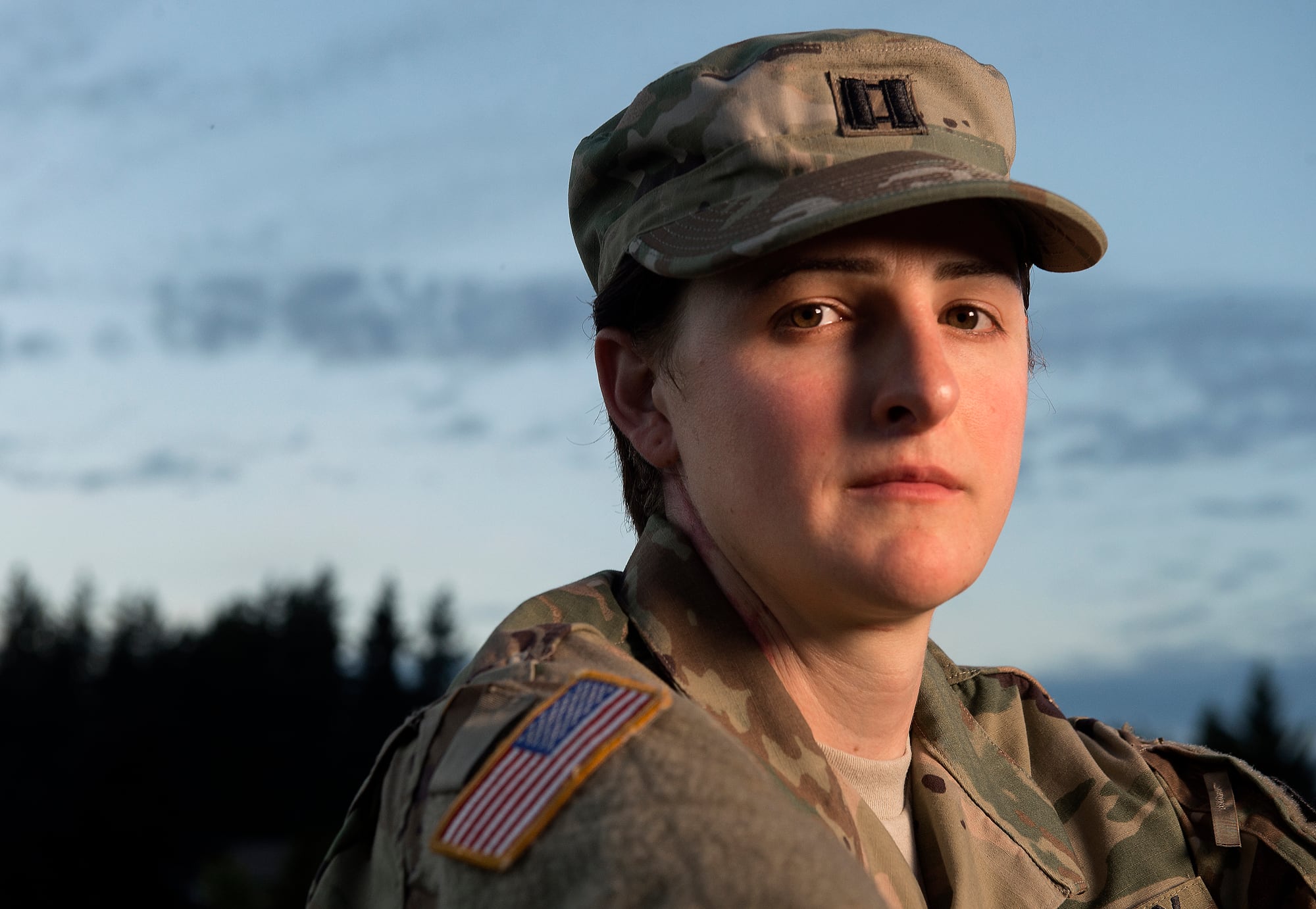TACOMA, Wash. — As she came to realize her true gender as a woman, Jennifer Peace knew she needed to have two difficult conversations.
The first would be with her wife, Deborah.
The second would be with the Army.
Until then, she was known as a male intelligence officer with a bright future who'd just returned from a second combat deployment.
Almost three years later, Capt. Peace is happier than ever with her wife and three children.
But she's still waiting to find out what the Army has in store for her.
"It's excruciating," said Peace, 30, a Spanaway resident who works as an intelligence officer at Joint Base Lewis-McChord.
She's a soldier not-so-patiently waiting for a new Pentagon policy she's almost certain will repeal the Defense Department's ban on transgender military service members.
Defense Secretary Ash Carter has signaled the policy change repeatedly in the last year. He convened a working group tasked with figuring out how to integrate transgender troops into ground-level units.
So far, Carter has made clear that the Defense Department won't discharge transgender military service members. Kicking someone out of the Armed Forces for that reason now requires approval from an assistant secretary of defense.
But until Carter's group finishes its assignment, the Army has no guidelines on how to process and promote transgender soldiers who until March faced a summary discharge because of who they are.
"There's a collective holding your breath," said Sue Fulton, a former Army officer who is president of a transgender military advocacy group called SPARTA.
"There is joy in knowing that change is coming and that you'll be able to live as your authentic self and continue to serve honorably," Fulton said, "but at the same time that isn't happening today, that's a few months down the road."

Capt. Jennifer Peace, left, and her spouse, Deborah, enjoy hanging out with their kids at a playground near their home in Spanaway, Wash. Peace is one of an estimated 15,000 transgender people who serve in the active-duty military. She's speaking out in the hopes of helping people understand transgender men and women.
Photo Credit: Drew Perine/The News Tribune via AP
For now, Peace and other service members are left in a sort of limbo.
Although she's spent more than $50,000 on her transformation, legally changed her name and been known to her commanders as a woman for nearly a year, her peers are still under formal orders to refer to her as a man.
Peace last week began a new assignment at JBLM's 7th Infantry Division, where she expects to serve for about a year. She worries that a future commander weighing candidates for an intelligence officer will choose someone else when he reads a personnel packet that shows her name is Jennifer but features a photo of her in a male uniform.
Her biggest fear, she says, is being introduced to a new commander as a transgender soldier — not as a highly qualified, capable intelligence officer.
Peace is speaking out in the hope of helping people understand transgender men and women. Earlier this year, she was bothered when she saw letters to the editor in local newspapers disparaging the military's effort to allow its transgender personnel to serve openly.
Now she's one of a handful of active-duty troops around the country who've publicly identified themselves as transgender. She believes she owes it to the Army to help it learn how to incorporate transgender people who want to serve their country.
"We're losing qualified soldiers because of this," she said.
About 15,000 transgender people serve in the active-duty military and its reserves, according to a 2014 study by the Williams Institute at UCLA. That report found that transgender men and women join the military at higher rates than the general population.
Secretary Carter acknowledged they've been serving in war while keeping their identities a secret.
"At a time when our troops have learned from experience that the most important qualification for service members should be whether they're able and willing to do their job, our officers and enlisted personnel are faced with certain rules that tell them the opposite," Carter said when he created the Defense Department working group in July
The transgender reforms are coming relatively quickly after the repeal of the Pentagon's "don't ask, don't tell" policy, which barred gay troops from serving openly in the military from 1993 until 2011.
Transgender advocates are looking back to that historic milestone for a sense of how a new policy affecting them might be adopted. It took the Pentagon nine months after the official repeal of "don't ask, don't tell" to set policies in place that would enforce it.
"I'm confident (the members of the transgender working group) are keeping military readiness first and foremost, and I'm confident that the result will make the Armed Forces stronger," Fulton said.
'Always knew something was wrong'
Like many young people, Peace found her way to the Army with a dream to make something of herself. She said she was just shy of homeless growing up in Houston. She didn't fit in and dropped out of high school.
At 19, she enlisted in the Army and married her wife, Deborah. Back then, she was a man, albeit uncomfortable in her own skin.
"I always knew something was wrong, but I didn't know what it was," Peace said.
Her Army career took off; she was highly regarded first as an enlisted soldier and later as an officer analyzing battlefield intelligence. She graduated at or near the top of every military intelligence training course she took.
"Capt. Peace is the best military intelligence officer I have served with in over 18 years of service," read one of her officer evaluations from 2013.
Even so, her feelings of not belonging persisted, peaking during her 2012 deployment to Afghanistan. It was her second tour in a war zone, having served in Iraq four years earlier.
She felt out of place in shared quarters for men. She'd work out, shave, restyle her haircuts and do "everything I could to change my body."
Back home, Peace felt her depression linger long after the deployment and her reunion with Deborah.
Peace remembered feeling emotionally flat, as if she couldn't connect with Deborah and their two sons. Both spouses say they fought "horribly."
Although uncomfortable with her body as a man, Peace hadn't considered the possibility that she could be transgender until then. She sought out information in online communities, and something clicked for her.
"I immediately identified with everything," she said. "I knew who I was."
That meant she'd have to tell Deborah.
Peace's transformation to a woman would change her wife's identity almost as much as her own. It meant Deborah would have to learn to think of herself as a lesbian to keep their family together.
Initially, Deborah shot down Peace's attempts to bring up her desire to become a woman. They'd been married nine years, and Peace had never shown curiosity about being transgender before. In fact, Deborah at that time was pregnant with the couple's third child, a daughter.
"I was very angry at first," Deborah said.
But Peace persisted, telling her wife that "it's just this feeling of wrongness, and when you put a word on it, it only becomes worse."
'You have to move forward'
Gradually, Deborah listened and learned.
Over months, she confronted fears that Peace would leave her. She came to feel she was mourning the death of her husband so she could move forward with her wife.
"I cried for a good solid month, and I was depressed, and I mourned my spouse," Deborah said.
Jennifer "was always there, I just didn't know she was there," Deborah said. "She is the same person. She's happier. That's the thing. It was something I had to go through."
Once Deborah embraced the family's new identity, she began nudging Peace to follow through with her transformation.
"I told her 'you have to move forward or I'm not going to do this,' " Deborah said.
That meant reaching out to other transgender military service members in SPARTA, beginning hormone replacement therapy and undergoing several small surgeries that would accentuate her appearance as a woman.

Jennifer Peace, right, and her spouse, Deborah, read books with their children before putting them to bed at their home in Spanaway, Wash.
Photo Credit: Drew Perine/The News Tribune via AP
It also required Peace to tell her extended family. Her mother did not take the news well, although they've begun to repair their relationship. She characterized Deborah's family as supportive.
They told their two boys, now ages 7 and 9, that their father would become a woman, and they did it in "a very direct way."
"We just told them, 'This is who I am,' " Peace said.
"The kids were great once we said we both still love them," she said.
At home, they said they discovered a richer family life that had eluded them earlier in their marriage.
"I'm a better parent," Peace said. "When my two boys were young, I didn't spend time with them. It was a general malaise. I didn't have the feelings and emotions I have now. There is no way I could ever imagine being that person again."
Her work at Joint Base Lewis-McChord would be a different story.
Army orders tests, evaluations
Peace began transitioning into a woman in January 2014, but was able to maintain a separate male identity in her Stryker brigade until she participated in a military exercise in Malaysia eight months later.
There, soldiers in close quarters noticed that she'd begun wearing a bra.
She took a medical leave after the Pacific exercise so she could make time for a facial surgery. While she recovered, she received a Facebook message from another soldier telling her that her command knew about her change.
It was a supportive message, but one that conveyed to Peace that the Army had learned of her transformation from someone other than her.
"I felt like that was something for me to tell," Peace said.
The news prompted a series of meetings with senior officers and enlisted soldiers in Peace's unit at the time, the 1st Battalion, 17th Infantry Regiment of the 2nd Brigade, 2nd Infantry Division.
The meetings led to Peace being compelled to take psychiatric tests and medical evaluations. She felt commanders tried to be supportive early on, but later they issued orders instructing her peers to continue referring to her as a man.
That order, though hurtful to transgender soldiers, reflects the Army's current policy and likely will not change until the Pentagon issues new guidelines.
"The current policy on the service of transgender individuals has not changed," JBLM's I Corps headquarters said in response to questions from The News Tribune. "Current Army policy is that the Army will only recognize soldiers by the gender they held when they entered the Army."
For Peace, living under that policy is a stark contrast to her life at home. The family has removed any obvious reference to her as a man — no wedding pictures, no certificates for Army commendations, and no photographs showing her with her children in their toddler years.
They also declined to share any photos of Peace as a man with The News Tribune. The newspaper learned her previous first name from her Army service records, but agreed not to publish it (along with the names of their children).
"It's just not me anymore," Peace said.
'Potential is unlimited'
Reaching out to other transgender military service members, Peace found they faced a wide variety of responses when commanders learned of their identities.
Some received blessings from leaders affirming their changes; others were kept in positions leading dual lives. That variance won't change until Secretary Carter's working group releases its finding and sets a path for new policies.
The military has said "we're not going to discharge trans people, but we haven't said what we're going to do with you," Peace said.
Despite the stress, she continues to excel at work.

Transgender Joint Base Lewis–McChord soldier Capt. Jennifer Peace poses near her home in Spanaway, Wash.
Photo Credit: Drew Perine/The News Tribune via AP
"Capt. Peace's work performance was always exceptional, always a good soldier," said an officer who supervised Peace in the Stryker brigade. He spoke on condition that he not be named because he did not want to get ahead of official Army policy.
Capt. Luke Sanderson, an intelligence officer who serves with Peace in the division headquarters, was also complimentary.
"She's very professional. She knows the doctrine. She knows how things are supposed to happen, and she knows how to make them happen," said Sanderson, 27.
As far as Sanderson knows, Peace is the first transgender soldier he's met in his five years of military service. He said he hasn't seen soldiers treat her unfairly or discriminate against her.
Sanderson said the Army has some learning to do as it carries out the expected policy change.
"One of the problems is a lack of education," he said. "People just don't know what problems and stresses occur when someone is going through the process of transition. If something's new and scary, people alienate or make fun of it and be afraid of it."
Peace received her last performance evaluation from her battalion commander in April, five months after her unit officially learned of her identity as a transgender woman. It ranked her as one of the battalion's top captains and urged her promotion.
"Capt. Peace's potential is unlimited. Promote to major and send to (an academy for majors) now," the evaluation reads.
She's not looking back.
"I really believe this is my Army as much as anyone else's. I deserve to be here, to serve in the organization and make it better. This is something I'm not willing to quit because things are hard."





